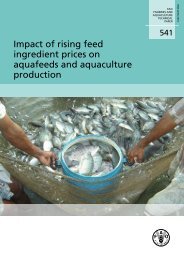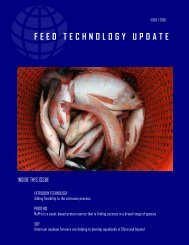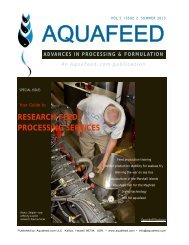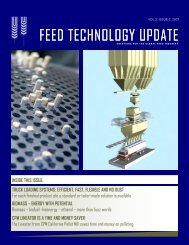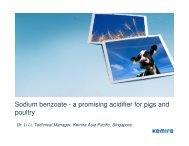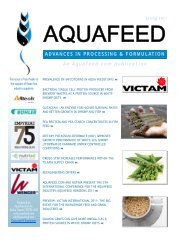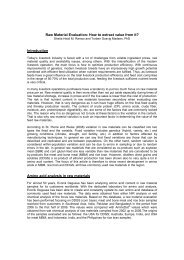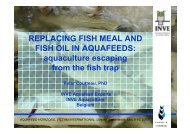FEED TECHNOLOGY UPDATE - AquaFeed.com
FEED TECHNOLOGY UPDATE - AquaFeed.com
FEED TECHNOLOGY UPDATE - AquaFeed.com
You also want an ePaper? Increase the reach of your titles
YUMPU automatically turns print PDFs into web optimized ePapers that Google loves.
CASE STUDY<br />
ing.<br />
“Rain and cold weather slow down catfish<br />
feeding,” Robertson said.<br />
“If we start out in April without a lot of rain,<br />
and it warms up fast, we can get real busy<br />
in a hurry. Other years we’re into June<br />
before we get busy. But once that water<br />
gets warm, the fish start feeding and the<br />
race is on. We can run as much as 12 or 13<br />
thousand tons of feed in a month.”<br />
The Land O’Lakes Purina Feed mill at Macon<br />
has two extruder lines in the catfish feed<br />
production operation. “We’ve been progressively<br />
trying to increase production,”<br />
Robertson reported.<br />
“We started by increasing extruder speed.<br />
Originally, the extruders had 300-rpm output<br />
that were increased to 400-rpm. We’ve<br />
continually tried to do things that would<br />
increase throughput.”<br />
“When manufacturing catfish feed, we always<br />
know how fast we’re running because<br />
we monitor the speed of our feeder screws<br />
feeding the extruders,” Robertson said.<br />
“Actually we now have a panel view that<br />
tells us how many tons per hour is going<br />
through the machines. Over the years,<br />
we’ve learned that all of the work that’s<br />
done in the extruder is done at the end of<br />
the extruder (when the screws and liners<br />
are not worn). The final screw is the one<br />
that does the majority of the work<br />
(pushing)”<br />
“Over a period of time—two, three months,<br />
however long it is—that final screw begins<br />
to wear and the feed starts slipping back,”<br />
Robertson continued.<br />
“When this happens, the screws toward the<br />
back start having to do the pushing. The<br />
further that push moves back in the extruder,<br />
the more energy is required to the<br />
same amount of work. So, we have to slow<br />
the feed rate down to avoid overloading the<br />
motor.”<br />
So, what happens when they have to reduce<br />
the feed rate<br />
“As the push moves farther back, we begin<br />
to have fluctuation in the amps. When our<br />
amps get up high, the extruder is pushing<br />
feed out at a higher pressure. When it gets<br />
low, the pressure drops. It tends to fluctuate<br />
back and forth between high and low”.<br />
“First we’ve got feed expanding more than<br />
it’s supposed to. Then we get feed that’s<br />
smaller than it is supposed to be, so we end<br />
up with inconsistent sized feed that is both<br />
floating and sinking, with increased fines.”<br />
“Over the course of a typical year,” Robertson<br />
said, “We would replace liners and<br />
screws annually, before the beginning of<br />
catfish feeding season, usually in January.<br />
After the extruder has run about 1,600<br />
hours and produced about 20,000 tons of<br />
feed, production rates would drop significantly.<br />
At that time we replaced just the<br />
final screws. Usually we’d get another 1,200<br />
hours of service and produce about 15,000<br />
tons of feed before production began to<br />
drop again.”<br />
“At this point,” Robertson explained,<br />
“production levels were down about 20 percent.<br />
Depending on tonnage requirements<br />
at that time (being toward the end of catfish<br />
season), we would decide whether to<br />
replace any more screws and liners or wait<br />
until rebuild.”<br />
CLADDING THE SOLUTION<br />
“When Lorrie Muzzone from Conforma Clad,<br />
a Kennametal Company based in New Albany,<br />
Indiana, started talking to us about<br />
the wear resistance of cladded screws, it<br />
seemed like a natural thing to try,” Robertson<br />
said.<br />
“Of course, we were skeptical because everybody<br />
says ‘We’ve got the best and the<br />
greatest thing in the world.’ However, even<br />
though we had never done business with<br />
Conforma Clad before then, it seemed<br />
worth taking a chance, and it’s worked out<br />
very well.”<br />
“The main thing the cladded screws have<br />
• <strong>FEED</strong> <strong>TECHNOLOGY</strong> <strong>UPDATE</strong> — June/July 2006 •



